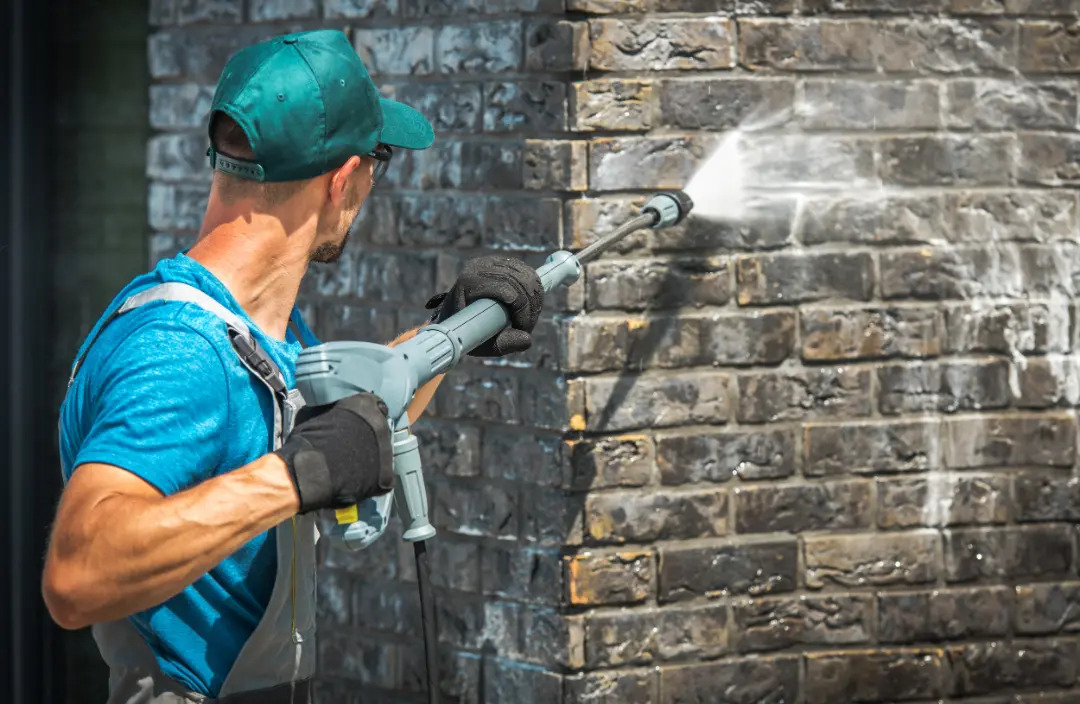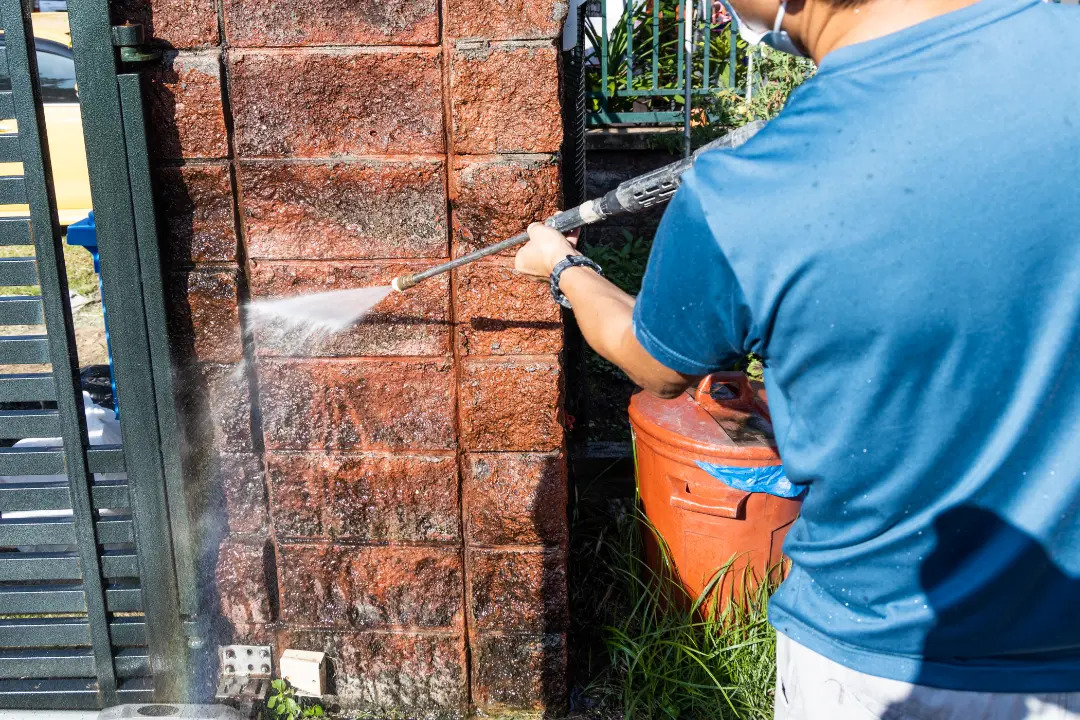Top Brick Cleaning Techniques: Essential Tips for Clean Brickwork
Tuesday December 3, 2024
Looking for effective brick-cleaning techniques? This article explains the best methods for different types of bricks and common stains. Discover how to clean your brick surfaces safely and effectively.
Key Takeaways
- Proper assessment of brickwork is crucial to identify damage and select appropriate cleaning methods, considering the specific type of bricks in use.
- To prevent damage, different cleaning techniques, such as pressure washing, chemical cleaning, steam cleaning, and abrasive methods, must be chosen based on the brick type and the contaminants present.
- Regular post-cleaning maintenance, including scheduled cleanings and protective sealants, is essential to preserve the aesthetic appeal and structural integrity of brick surfaces.
Assessing Your Brickwork
Before starting the cleaning process, assess the condition of your brick surfaces. Identify the types of bricks used and inspect for any damage that might worsen with cleaning. This evaluation helps identify potential structural issues and select suitable cleaning methods.
Common contaminants include algae, moss, efflorescence, lime staining, and metallic staining. It’s also important to ensure that stains do not indicate more serious structural issues.

Identifying Brick Types
Understanding the types of bricks on your property is key to selecting appropriate cleaning methods. Common brick types include burnt clay bricks and engineering bricks, each requiring specific cleaning approaches. Clay bricks are porous and need gentle cleaning to avoid damage.
Clay bricks should be left to dry seven days after installation to allow proper curing. Historical bricks, which often require more delicate cleaning methods, should also be identified.
Inspecting for Damage
Inspect for damage before any cleaning begins. Look for cracks and loose mortar joints, as these can worsen during the cleaning process and lead to serious structural issues. Regular inspections help maintain both the appearance and structural integrity of brick surfaces.
Identifying fine cracks and delicate surfaces allows you to choose cleaning methods that won’t exacerbate existing damage.
Common Brick Cleaning Techniques
Several brick cleaning methods are available, each suited to different types of brickwork and contaminants. From pressure washing and chemical cleaning to steam cleaning and abrasive cleaning systems, the choice of method depends on the specific needs of your brick surfaces.
Test any cleaning method on a small, hidden area first to ensure it won’t cause damage.
Pressure Washing
Pressure washing is a popular method for cleaning brick surfaces due to its effectiveness in removing dirt and grime. However, using high-pressure water can risk damaging both the brick and mortar. High-pressure washing can erode mortar joints and cause water penetration in bricks, leading to costly repairs. Use specialised equipment and proper cleaning solutions rather than relying solely on high-pressure washing for better results.
Avoid pressure washing on historical brick structures without expert evaluation, as it can cause irreversible damage. Gentle pressure washing can be effective for cleaning clay brickwork if done carefully, but always prioritise safety and the integrity of the brick surfaces.
Chemical Cleaning Methods
Chemical cleaning methods are effective for removing tough stains from brick surfaces. Here are some commonly used chemicals:
- Hydrochloric acid, which bricklayers commonly use to eliminate mortar stains
- Muriatic acid, which can address oily residues
- Boric acid, which can also be used for similar purposes
However, these chemicals can be corrosive and environmentally harmful, so handle them with care, wearing gloves and safety goggles.
Diluted proprietary acid or non-acidic cleaners specifically formulated for clay bricks are recommended for tough stains. Before using chemical cleaners, pre-wet the brick surface to prevent damage and limit the concentration of muriatic acid to a maximum of 10 per cent. This ensures the cleaning process is both safe and effective.
Steam Cleaning
Steam cleaning is an eco-friendly method for removing organic growth from bricks. It uses superheated water to clean brick and masonry effectively without harsh chemicals. This method is particularly suitable for fragile substrates in historic building renovations.
Steam cleaning can remove algae and moss, which trap moisture and cause damage to brick and mortar over time.
Abrasive Cleaning Systems
Abrasive cleaning methods, such as soda blasting, are suitable for removing tough residues while being gentle on fragile substrates. However, to prevent damage, carefully clean mortar and cement residues from heritage brickwork.
Avoid using metal brushes or tools on clay bricks, as these can damage the surface. Prioritise the integrity of the brick surfaces when using abrasive cleaning methods.
Removing Specific Stains from Brickwork
Different stains require different cleaning approaches. Common stains on brickwork include cement, mortar, limescale, rust, moss, algae, soot, and smoke. Choosing the appropriate cleaning method helps to avoid causing additional damage to the brick surfaces.
For example, green or yellow stains from moss or algae can be treated with appropriate cleaning methods, while soot and smoke stains can be removed using a paste of baking soda or cream of tartar mixed with water.

Efflorescence Removal
Efflorescence is caused by the evaporation of water carrying soluble alkali salts, resulting in white powdery deposits on bricks. Depending on the salts involved, they typically appear as white marks but can also manifest as brown, green, or yellowish stains.
Using a stiff brush is a simple method of removing efflorescence. Avoid high-pressure hoses, as they can worsen the issue.
Lime Staining
Lime staining occurs when excess water dissolves calcium hydroxide from mortar, depositing it onto the bricks. This often creates a dribbling pattern through holes or fine cracks between the brick-and-mortar joints.
Initial cleaning steps include using water and a brush. For more stubborn stains, chemical cleaners may be required; always test on a small area first.
Metallic Stains
Metallic stains, such as iron and manganese, can cause rust-like discolouration on bricks. These stains can be left to weather naturally, removed with a rough file, or treated with proprietary cleaning solutions.
For vanadium stains, avoid using hydrochloric acid; instead, use a dilute oxalic solution after testing it on a small area.
Paint Removal Techniques
Removing paint from brick surfaces requires safe and effective methods to prevent damage to the porous brick surface. Using a heat gun can effectively remove paint without causing damage, offering precision and control and reducing the risk of damage compared to abrasive methods.
Maintain a safe distance from the brick and keep the gun moving to prevent overheating.
Using Paint Removers
Chemical paint removers can be effective; test the remover on a small area first. Aerosol paints are particularly difficult to remove from brick surfaces. For fresh paint, soak up as much as possible, use a solvent, then wash with warm water and detergent.
Multiple applications of masonry paint remover may be necessary for thicker layers of paint.
Mechanical Methods
Before applying solvents, mechanical methods such as scraping with a trowel can help remove flaking paint. Scraping is effective but must be done carefully to avoid damaging the underlying brickwork.
Combining scraping with solvents can enhance cleaning by ensuring deeper penetration and removing residual paint.
Professional vs. DIY Brick Cleaning
Deciding between professional and DIY brick cleaning involves weighing factors like cost-effectiveness, expertise, and equipment. Professional cleaners possess specialised knowledge and advanced techniques, often leading to superior results. Hiring a professional service ensures safety and protects your property investment.
Verify contractors’ evidence of past work and appropriate insurance when hiring for chemical use.
Benefits of Hiring Professional Cleaners
Professional cleaners bring specialised knowledge and techniques to ensure effective professional brick cleaning services without causing damage. They use specific chemical detergents and high-pressure water jet cleaning tailored to different needs, often provided by a professional brick cleaning company.
Professionals are trained in chemical safety, ensuring the safe use of hazardous cleaning agents. Hiring professionals provides long-term cost savings by preventing damage and maintaining the aesthetic appeal of brick structures.
DIY Brick Cleaning Tips
DIY brick cleaning can be effective with the right tools and techniques for those who prefer a hands-on approach. Nylon brushes are recommended for their gentle yet effective cleaning. Avoid using wire brush tools, as they can scratch the brick surface and cause permanent damage.
Mechanical cleaning methods can be labour-intensive and risk damaging bricks if not done carefully.
Post-Cleaning Maintenance
Maintaining clean brickwork involves regular cleaning and protective measures. Consistent cleaning prevents the buildup of stubborn stains and long-term damage. Gentle cleaning solutions and soft-bristled brushes help maintain the appearance of the brickwork after professional cleaning.
Regular maintenance preserves both aesthetics and durability.
Regular Cleaning Schedule
A regular cleaning schedule prevents dirt buildup and maintains the aesthetic appeal of brick surfaces. Gentle cleaning methods preserve the integrity and appearance of brick material. Cleaning bricks during cooler parts of the day can prevent uneven drying and damage.
Regular cleanings enhance the longevity and visual appeal of brickwork. Consider hiring brick cleaning services for optimal results.
Protective Measures
Protective sealants, such as silicone-based sealants, offer robust protection against water penetration and staining. Applying a sealant after cleaning helps maintain the condition of the brickwork and makes future cleaning efforts more effective.
Treatments like Masonry Protection Cream can enhance the longevity of brick cleanliness.
Environ Restoration Services: Expertise in Brick Cleaning
Environ Restoration Services specialises in maintaining properties’ historical significance and beauty while employing modern conservation practices. They offer various specialised services, including heritage building restoration and consultations.
The company’s expertise includes handling delicate heritage works, extensive stone and brick restoration, and intricate structural repairs.
Tailored Restoration Solutions
Environ Restoration Services provides tailored restoration solutions that respect original architecture and materials. Historical bricks require careful restoration techniques to maintain their integrity and appearance. The company handles the historical value of buildings during restoration, ensuring cost-effective and meticulous execution.
Combining Tradition with Technology
Environ Restoration Services combines traditional craftsmanship with modern technology to ensure quality and reliability. They are committed to preserving properties’ historical significance and beauty while employing modern conservation practices.
The company’s approach combines technical expertise with a deep understanding of aesthetic restoration.
Summary
Clean brickwork is essential for maintaining your property’s aesthetic appeal and structural integrity. Assessing your brickwork before cleaning, understanding the different cleaning techniques, and knowing how to remove specific stains are all crucial steps in the cleaning process. Whether you choose to hire professional brick cleaners or take on the task yourself, it’s important to follow proper cleaning methods to avoid causing damage. Environ Restoration Services stands out as a reliable choice for professional brick cleaning services, combining traditional skills with modern technology to deliver exceptional results. Regular maintenance and protective measures will ensure your brick surfaces remain in pristine condition for years to come.
Frequently Asked Questions
What are the common types of bricks, and how should they be cleaned?
Common types of bricks include burnt clay bricks and engineering bricks. Clean clay bricks gently to avoid damage, while engineering bricks may require stronger cleaning methods to maintain their integrity.
Is pressure washing safe for all types of brickwork?
Pressure washing is unsafe for all types of brickwork, as it can damage brick and mortar, particularly in historic structures. Obtaining expert evaluation before proceeding with pressure washing on bricks is essential.
How can I remove efflorescence from my brick walls?
Use a stiff brush for scrubbing to remove efflorescence from your brick walls effectively. Avoid high-pressure hoses as they can exacerbate the problem.
What are the benefits of hiring professional brick cleaners?
Hiring professional brick cleaners ensures effective cleaning while minimising the risk of damage. Their specialised knowledge and techniques, along with the use of appropriate detergents and equipment, lead to safer and more cost-efficient results.
How often should I clean my brick surfaces?
It’s best to clean your brick surfaces at least once a year to prevent dirt buildup and preserve their appearance. Regular maintenance will keep your bricks looking their best.



















